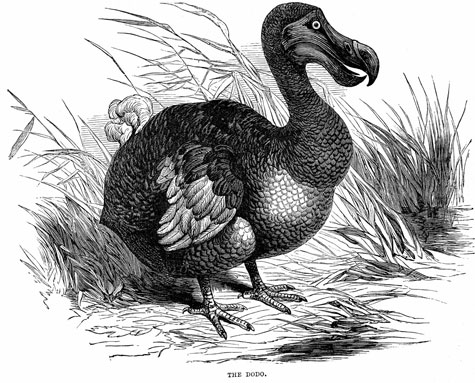Eminent Harvard biologist E.O. Wilson says that fully half of the planet’s higher life forms could be gone within 100 years, joining the dodo bird, sketched here, which has been extinct since the 17th century and whose fate was directly attributable to human activity. Photo: Thinkstock
Dear EarthTalk: I heard that species of flora and fauna are dying at a growing rate globally. How is this calculated and which types of species are dwindling faster?
–– Colin Gooder, Franklin, NC
Researchers believe that the rate of species loss currently underway is 100-1,000 times faster than what was normal (the so-called “background rate” of extinction) prior to human overpopulation and its negative environmental effects. But thanks to overhunting, deforestation, pollution, the spread of non-native species and now climate change, we are likely in the midst of the sixth mass extinction in the geologic history of the world. The previous mass extinction, 65 million years ago, wiped out the dinosaurs and other species; the previous one, 250 million years ago, killed off 90 percent of all species on the planet.
While the current mass extinction might in reality not be that bad—only time will tell—eminent Harvard biologist E.O. Wilson predicts that the rate of species loss could top 10,000 times the background rate by 2030, and that fully half of the planet’s higher life forms could be gone within 100 years. This jibes with statistics from the non-profit International Union for the Conservation of Nature (IUCN)—keeper of the global “Red List” of endangered species—which currently considers 37.8 percent of the world’s already classified species to be threatened. Of course, this is far from the whole story, as biologists think that we have only classified 10 percent or less of the world’s total number of plant and animal species.
Which types of species are being hit hardest? An analysis of IUCN statistics from 2008 found that of the world’s fauna (animals), invertebrates (animals without backbones, such as earthworms, shellfish and insects) were suffering the most, with 40.5 percent of those classified considered threatened. Next hardest hit were fish species, with 36.6 percent threatened, followed by reptiles at 30.5 percent and amphibians at 30.4 percent. Meanwhile, 20.8 percent of mammal species were threatened and 12.2 percent of birds.
More shocking was the statistic that some 70.1 percent of plant species are at risk. However, a more recent (2010) study found that only 22 percent of the world’s classified plants are actually facing extinction. This finding has led analysts to question conservationists’ estimates in regard to animal species loss as well.
In lieu of any direct way to measure the rate of species loss, conservationists have relied on reversing the so-called “species-area relationship,” whereby scientists tally the number of species in a given area and then estimate how quickly more show up or evolve as viable habitat increases (or decreases in the case of reversing the concept). But lately this method of tracking and predicting species losses has been criticized for generating overestimates. “The overestimates can be very substantial,” argues UCLA evolutionary biologist Stephen Hubbell, “…but we are not saying [extinction] does not exist.”
However many species may be dying, it’s clear we are in the midst of another mass extinction, and if you believe 70 percent of biologists, unlike previous mass extinctions humanity is most likely the cause. Conservationists remain optimistic that we can marshal the resources to turn the tide—and we’ll need to if the planet is to remain habitable for our species, given our own dependencies on the world’s biodiversity.
CONTACTS: E.O. Wilson Biodiversity Foundation, www.eowilson.org; IUCN, www.iucn.org; “Species-area relationships always overestimate extinction rates from habitat loss,” www.nature.com/nature/journal/v473/n7347/full/nature09985.html.
EarthTalk® is written and edited by Roddy Scheer and Doug Moss and is a registered trademark of E – The Environmental Magazine (www.emagazine.com). Send questions to: [email protected]. Subscribe: www.emagazine.com/subscribe; Free Trial Issue: www.emagazine.com/trial.








